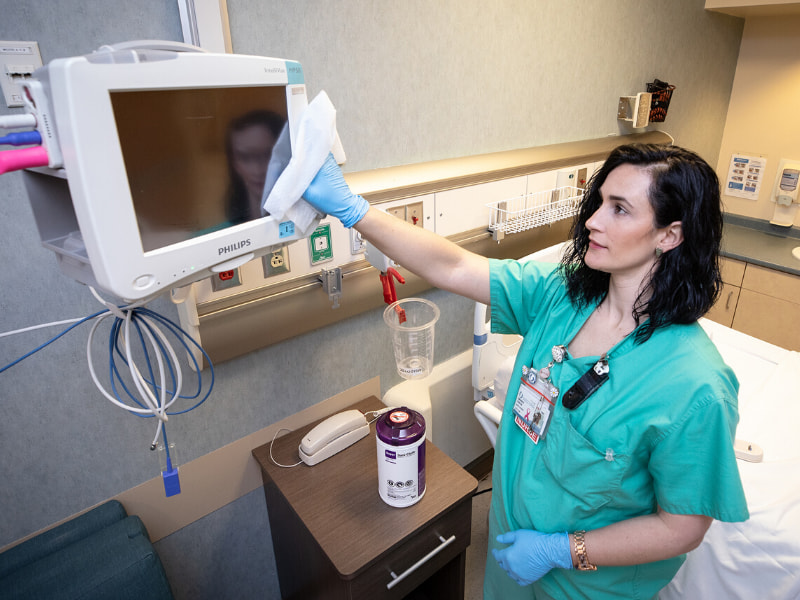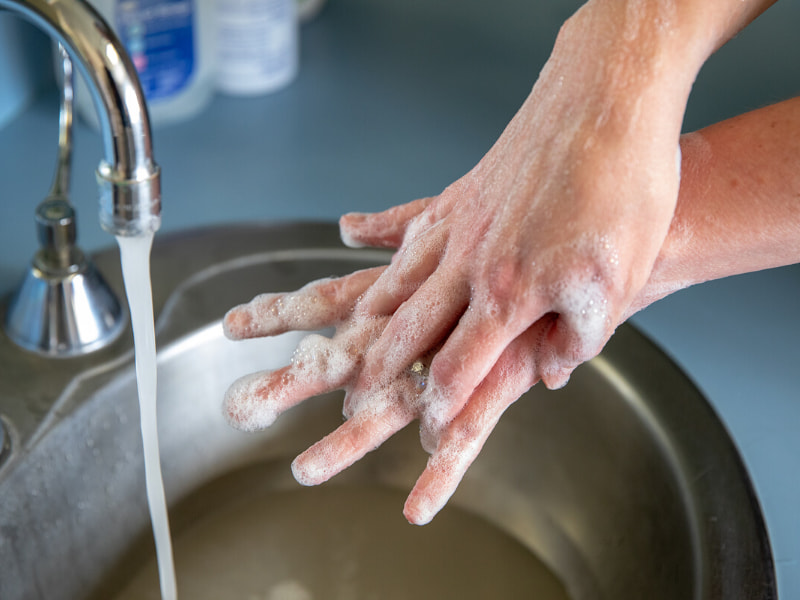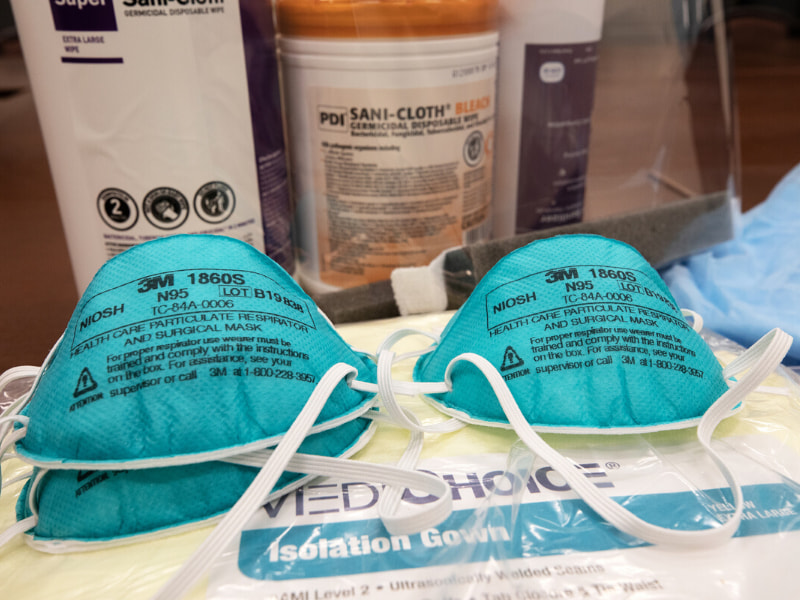COVID-19 infection prevention: Employee questions answered

Editor's Note: This article was updated on March 13 to reflect new information.
Many of the same common-sense precautions against seasonal influenza should be followed as COVID-19 is identified in the state and as the outbreak continues across the nation, UMMC infectious diseases and infection prevention specialists say.
Early the evening of Wednesday, March 11, the Mississippi State Department of Health (MSDH) reported the state’s first presumptive positive case of COVID-19. Final verification will come from the Centers for Disease Control and Prevention (CDC). The individual is a Forrest County man who recently traveled to Florida. The patient voluntarily isolated himself at home to prevent further transmission to others and was not hospitalized, and MSDH is investigating to limit spread of the virus from this case.
Two more cases were identified March 13: a Forrest County woman over 65 who recently traveled to North Carolina and is hospitalized; and a Forrest County man who recently traveled to Florida, and who is home self-isolating and didn’t require hospitalization.
Earlier Wednesday, the World Health Organization declared COVID-19 a global pandemic.
Dr. Bhagyashri Navalkele, assistant professor in the Division of Infectious Diseases and medical director of Infection Prevention, and Sheila Fletcher, a registered nurse and director of Infection Prevention, have answered frequent questions from employees and students on how to protect themselves from the virus.

If an employee or student is on the job or in class and begins to feel ill, Navalkele said, those working in a patient care area should immediately isolate themselves from patients and other health care workers. Any employee who believes they may be ill should alert their supervisor of symptoms, and based on those symptoms, the person might be relocated to a non-patient care area or advised to go home to avoid risk for exposure to other staff. Be cognizant of the flow chart prepared by Infection Prevention on how to identify, isolate and call for assistance.
The CDC advises people consider these sets of symptoms in evaluating what illness they might have. Itchy eyes, stuffy nose and sneezing are symptoms of a cold or allergies. Fever, fatigue, body aches, cough and worsening symptoms can be the flu or COVID-19. Adding shortness of breath, a travel history and exposure to someone with COVID-19 could mean you have COVID-19.
However, symptoms and risks vary from person to person, so always check with your doctor.
If you’re at home and feel ill, stay home. Check with your provider, report your symptoms and ask about a safe time to return to work. Feel free to call Student and Employee Health for advice as well.
Here are some immediate infection prevention instructions from Navalkele and Fletcher for those working or schooling at the Medical Center:
As an employee or student, what precautions should I take if I am …
- Riding the shuttle
Avoid close contact with a sick person, especially those coughing or sneezing. Carry alcohol-based hand sanitizer with you and use it before and after riding on the shuttle. Avoid touching your eyes, nose or mouth to avoid lodging virus particles from surfaces onto your mucus membranes.
- Eating in the cafeteria, student union or other Medical Center restaurant
Avoid close contact with someone who is coughing or sneezing. Wash your hands with soap and water or alcohol-based hand sanitizer before and after eating.
- Using my cell phone
Cell phones are likely the most commonly used and least disinfected equipment carried by students and health care workers. Cell phones, like other surfaces, can harbor bacteria and viruses and serve as a mode of transmission. Cell phones can be disinfected using alcohol wipes. Cleaning cell phones at the end of the workday is reasonable.
- Hugging others or shaking hands
Close contact with a sick person is the most common mode of transmission of viral illnesses, including COVID-19. In view of widespread cases in the world and across some states, adapt some no-touch greeting methods, such as a fist bump, elbow bump, nod/wave, or a smile.
- Using Medical Center bathrooms, whether public or those in traditionally non-public areas
Environmental surfaces can harbor bacteria and viruses. Touching any of them and then a mucus membrane (eyes, nose, mouth) increases your risk for acquiring infections. Our housekeeping staff works meticulously to clean Medical Center surfaces, including those in bathrooms, but cleaning every moment of the day is difficult. Employees and students share a responsibility to follow hygienic measures to protect themselves. It’s in your best interest to always wash hands with soap and water, or use an alcohol based hand sanitizer, before exiting a bathroom. Remember to use your elbow or a paper towel to turn off the tap and to open the bathroom door as you exit.
- Typing on my keyboard and using my desk
Any environmental surface in a patient care area or non-clinical area can get contaminated with germs. Regularly clean your desk, keyboard and other highly touched surfaces with disinfectant wipes.
- Going to meetings around campus
Running around to meetings and greeting co-workers is common for some employees. To ensure your safety and that of your colleagues, carry alcohol-based hand sanitizer with you and use it before and after a meeting. Adapt some no-touch greeting methods such as a fist bump, elbow bump, nod/wave and a smile. If you are sick, stay home and attend the meeting via phone or Webex. Remind your colleagues to do this when needed.
- Sharing food or drink with others
Certain infections can spread through food or drinks, so it’s advised to avoid sharing them.
- Sitting close to others in class or lab
Avoid close contact with a colleague who is sick or appears sick, especially if they are coughing or sneezing. Always carry alcohol-based hand sanitizer with you and use it before and after class or lab. Avoid touching your eyes, nose or mouth to avoid lodging virus particles from surfaces onto your mucus membranes.
- Opening doors that require touching handles, pushing elevator buttons or light switches, using handrails inside or outside the Medical Center
Such high-touch surfaces in any area of campus have high risk for contamination with germs. It’s important to wash your hands with soap and water or use an alcohol-based hand sanitizer after touching these surfaces, and avoid touching your eyes, nose or mouth.
- Riding in my car to and from work
Always keep alcohol-based hand sanitizer in the car. Your car can serve as a medium to transfer germs from hospital to home, or from home to hospital. It is important to regularly clean and disinfect your car (inside and outside) with appropriate disinfectants.
- Going to hear speakers, or attending other optional group activities around campus
Close-contact and group activities carry risk for transmission of germs. Be mindful and avoid attending such events at work, or even in community, if there is ongoing widespread transmission of a communicable disease.
Other frequently asked questions pertaining to infection prevention:
- Should I wear a mask?

Only front-line caregivers and patients with respiratory symptoms or suspected or confirmed COVID-19 need to wear a N-95 mask designed to block droplets released into the air by someone who coughs or sneezes.
The national shortage of medical supplies and personal protective equipment continues because some of those who don’t need protection are buying it up or taking it, potentially leaving front-line caregivers and patients without.
“The Centers for Disease Control and Prevention recommends healthy people not wear a mask for protection against any respiratory illness, including COVID-19,” Navalkele said. “The only indications for wearing a mask include those who have respiratory symptoms so that they can avoid spreading germs to others, or if you are taking care of a sick person with respiratory illness.
“Follow appropriate droplet and airborne isolation precautions before entering a patient room,” she said. “Make sure you are following appropriate donning and doffing practice for masks to avoid contamination. Perform hand hygiene before and after removing your mask.”
- What should I do if frequent hand washing or sanitizer use makes my hands raw and chapped?
“Try to use hand lotion at periodic intervals to reduce drying of your skin. You can also perform hand hygiene with soap and water periodically, if hand sanitizing products are cause for skin irritation,” Navalkele said. “We encourage you to file an employee injury report and seek advice from Student and Employee Health for further management. You might need a dermatology consultation to evaluate for allergic dermatitis.”
- What should I do if I notice that a foam dispenser around campus is empty?
If it’s in a patient care area, inform the charge nurse. Patient care areas have a supply of foam dispensers for refill. If a refill is not available, or if you see a dispenser in public or non-clinical areas that is empty, contact Environmental Services at 4-2685.
- What should I do if I am returning from travel in a high-risk area, regardless of whether or not I feel ill?
When a faculty, staff or student returns from a location identified by the CDC as Level 2 or Level 3 risk, they will not return to work or school for 14 days and should be monitoring for symptoms at home.


